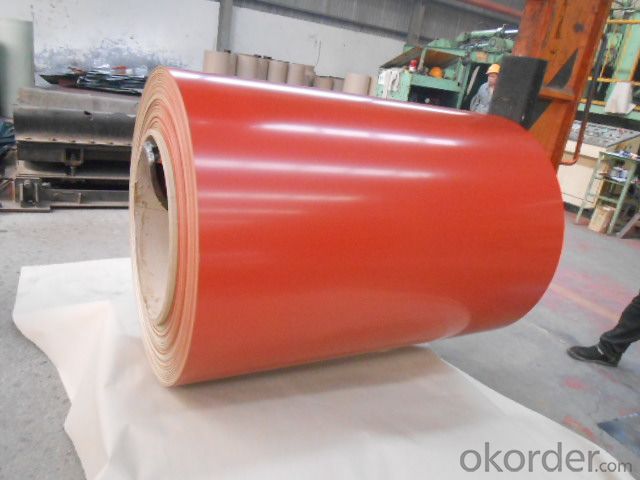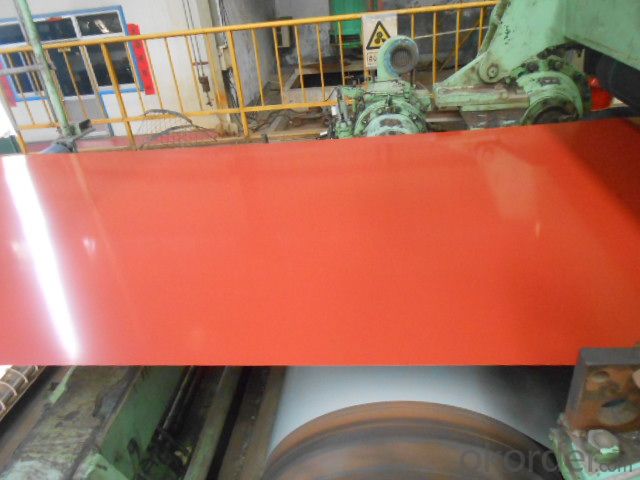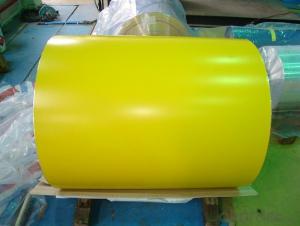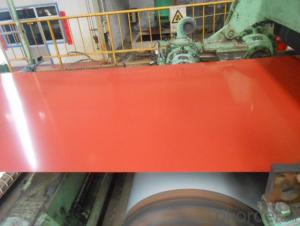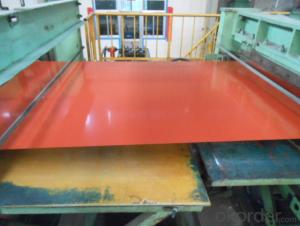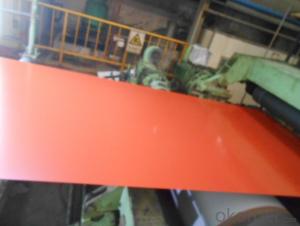Pre-Painted Steel Coil High Quality Red Color PPGI
- Loading Port:
- Shanghai
- Payment Terms:
- TT OR LC
- Min Order Qty:
- 200 m.t.
- Supply Capability:
- 20000 m.t./month
OKorder Service Pledge
OKorder Financial Service
You Might Also Like
1. Pre-Painted Galvanized/Aluzinc Steel Coil Description:
With GI as base material, after pretreatment (degrease and chemical treatment ) and liquid dope with several layers of color, then after firing and cooling, finally the plate steel is called pre-painted galvanized (aluzinc) steel. Pre-painted galvanized steel is good capable of decoration, molding, corrosion resistance. It generally displays superior workability, durability and weather resistance.
2.Main Features of the Pre-Painted Galvanized/Aluzinc Steel Coil:
• Excellent process capability
• Smooth and flat surface
• Workability, durability
• Excellent heat resistance performance
• High strength
• Good formability
• Good visual effect
3.Pre-Painted Galvanized/Aluzinc Steel Coil Images
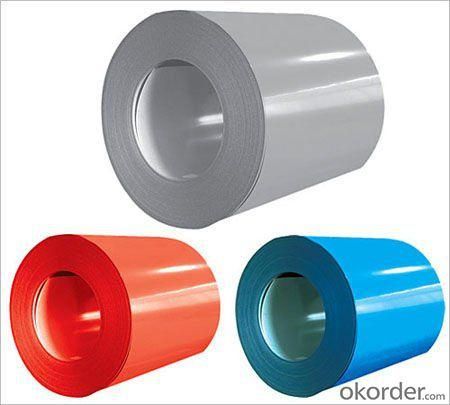
4.Pre-Painted Galvanized/Aluzinc Steel Coil Specification
Standard: AISI, ASTM, BS, DIN, GB, JIS
Grade: DX51D, DX52D
Thickness: 0.17-2.0mm
Brand Name: KMRLON
Model Number: coil
Type: Steel Coil
Technique: Cold Rolled
Surface Treatment: Coated
Application: Boiler Plate
Special Use: High-strength Steel Plate
Width: 20-1250mm
Length: customized
commoidty: pre-painted galvanized steel coil
Thickness: 0.13-4.0mm
width: 20-1250mm
zinc coating: 40-180g/m2
printing thickness: top side: 20+/-5 microns, back side: 5-7 microns
color: all RAL color
surface treatment: color coated
coil weight: 4-7 tons
coil ID: 508/610mm
packaging: standard seaworthy packing
5.FAQ of Pre-Painted Galvanized/Aluzinc Steel Coil
1. What’s the application of this product?
Roof, roof structure, surface sheet of balcony, frame of window, etc.
2. What’s the brand of the paint?
We use the best brand of all of the word—AKZO.
3. How to guarantee the quality of the products?
We have established the international advanced quality management system,every link from raw material to final product we have strict quality test;We resolutely put an end to unqualified products flowing into the market. At the same time, we will provide necessary follow-up service assurance.
4. How long can we receive the product after purchase?
Usually within thirty working days after receiving buyer’s advance payment or LC. We will arrange the factory manufacturing as soon as possible. The cargo readiness usually takes 15-25 days, but the shipment will depend on the vessel situation.
- Q: What are the main characteristics of galvanized steel coils?
- The main characteristics of galvanized steel coils include a protective zinc coating that prevents corrosion, high strength and durability, excellent formability and weldability, and a smooth and shiny surface finish.
- Q: How are steel coils used in the production of gutters and downspouts?
- Steel coils are used in the production of gutters and downspouts as they are uncoiled and fed into a roll-forming machine. This machine shapes and cuts the steel into the desired gutter or downspout profiles. The steel coils provide the necessary raw material for creating durable and long-lasting gutters and downspouts that effectively channel rainwater away from buildings.
- Q: What are the common coil tests performed for quality control?
- The common coil tests performed for quality control include dimensional measurements, visual inspection for defects or damage, hardness testing, tensile strength testing, and surface finish evaluation.
- Q: Is there a type of spray paint that would work on Stainless steel?That would also be permenant or at least make it through a wash or two?
- I've also learned something today! Good luck and have fun!
- Q: How are steel coils inspected for bendability using bend testers?
- Steel coils are inspected for bendability using bend testers, which are specialized machines designed to measure the flexibility and bend resistance of the coils. The process involves several steps to ensure accurate and reliable results. Firstly, the steel coil is prepared by securing it firmly in place, usually using clamps or other mechanisms to prevent movement during testing. This ensures that the coil remains stable and allows for consistent and repeatable measurements. Next, the bend tester is set up according to the specified testing parameters. These parameters typically include the desired bend angle, the speed at which the bend is applied, and the number of cycles to be performed. The bend tester is equipped with a bending mechanism that exerts a controlled force on the coil, simulating the bending conditions it may undergo during its application or use. Once the bend tester is set up, the bending process begins. The machine applies a gradually increasing force to the steel coil until it reaches the desired bend angle. This force is carefully measured and monitored throughout the process to ensure accuracy. During the bending process, the machine records and displays important data, such as the applied force, the angle of bend, and any indications of cracking or other defects. This data is crucial for evaluating the bendability of the steel coil and determining whether it meets the required standards. After the desired bend angle is reached, the coil is released from the bending mechanism, and any residual stresses are allowed to relax. This relaxation period is important to observe any potential spring-back effect, where the coil partially returns to its original shape after bending. The amount of spring-back is also measured and recorded for further analysis. Finally, the inspection results are analyzed to determine the overall bendability of the steel coil. If the coil meets the specified bendability criteria, it can be considered acceptable for its intended application. However, if any cracks, fractures, or excessive spring-back are detected, further investigation and analysis may be required to identify the cause and determine appropriate corrective actions. In conclusion, bend testers play a vital role in inspecting steel coils for bendability. Through a controlled and systematic process, these machines accurately measure the flexibility and resistance to bending, helping to ensure the quality and reliability of steel coils used in various industries.
- Q: What are the different types of steel coil slitting blades?
- There are several different types of steel coil slitting blades, including circular slitting blades, crush cut slitting blades, and razor slitting blades. Each type has its own unique design and is used for specific applications in the steel coil slitting process. Circular slitting blades are commonly used for high-speed slitting and provide precise and smooth cuts. Crush cut slitting blades are designed to crush and shear the material, making them suitable for cutting delicate or fragile materials. Razor slitting blades have a sharp edge that slices through the material, making them ideal for thicker or tougher materials. Overall, the choice of blade type depends on the specific requirements of the slitting process and the type of material being cut.
- Q: My 8-year-old and 9-year-old boys have approached me with an interesting question. Does fire burn steel? One says yes, the other says no. Help me to settle yet another debate :)
- It can burn it... but not the sort of fire you would find at home... Ive actually done it before in a silversmithing class with a very hot blow torch. It takes a long time, the metal first goes pink, then glowing orange red... it stays that way for a while, and then 'cracks' kind of loudly and basically disintergrates very suddenly. A torch this hot has a very hard (noisy) flame which is very transparent. But you cant burn it in the fireplace.
- Q: would you consider steel a flexible substance...i am debating this with my coworkers.Thanks,
- Yes, looking at it from an engineering standpoint. Depending on it's shape it can be used for many applications where flexibility is important. Steel springs for example, or guitar strings. Whenever you're debating these kinds of matters, it is important to keep in mind that the use of a material depends on the shape, the size and the weight it's going to be used in. A big block of steel will be used in a different manner as a piece of steel wire.
- Q: What are the common problems encountered with steel coils during production?
- Some common problems encountered with steel coils during production include surface defects such as scratches, rust, and scale formation, dimensional deviations, coil breaks or tears, edge defects, and coil slippage. Other issues may include coil handling and storage problems, coil winding or coiling defects, and quality control problems such as inconsistent chemical composition or mechanical properties.
- Q: How are steel coils inspected for surface finish using profilometry?
- Steel coils are inspected for surface finish using profilometry by measuring the surface topography using a profilometer. The profilometer scans the surface of the steel coil and records the deviations from the ideal surface. This data is then used to determine the roughness, waviness, and other surface parameters of the steel coil, providing a quantitative assessment of its surface finish quality.
Send your message to us
Pre-Painted Steel Coil High Quality Red Color PPGI
- Loading Port:
- Shanghai
- Payment Terms:
- TT OR LC
- Min Order Qty:
- 200 m.t.
- Supply Capability:
- 20000 m.t./month
OKorder Service Pledge
OKorder Financial Service
Similar products
Hot products
Hot Searches
Related keywords



